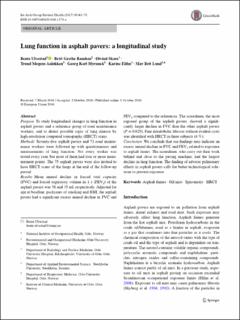| dc.contributor.author | Ulvestad, Bente | |
| dc.contributor.author | Randem, Britt Grethe | |
| dc.contributor.author | Skare, Øivind | |
| dc.contributor.author | Aaløkken, Trond Mogens | |
| dc.contributor.author | Mynarek, Georg | |
| dc.contributor.author | Elihn, Karine | |
| dc.contributor.author | Lund, May-Brith | |
| dc.date.accessioned | 2022-04-25T10:57:34Z | |
| dc.date.available | 2022-04-25T10:57:34Z | |
| dc.date.created | 2016-10-12T16:13:33Z | |
| dc.date.issued | 2016 | |
| dc.identifier.citation | International Archives of Occupational and Environmental Health. 2016, 90 (1), 63-71. | |
| dc.identifier.issn | 0340-0131 | |
| dc.identifier.uri | https://hdl.handle.net/11250/2992507 | |
| dc.description.abstract | Purpose: To study longitudinal changes in lung function in asphalt pavers and a reference group of road maintenance workers, and to detect possible signs of lung disease by high-resolution computed tomography (HRCT) scans. Methods: Seventy-five asphalt pavers and 71 road maintenance workers were followed up with questionnaires and measurements of lung function. Not every worker was tested every year, but most of them had four or more measurement points. The 75 asphalt pavers were also invited to have HRCT scans of the lungs at the end of the follow-up period. Results: Mean annual decline in forced vital capacity (FVC) and forced expiratory volume in 1 s (FEV1) of the asphalt pavers was 58 and 35 ml, respectively. Adjusted for age at baseline, packyears of smoking and BMI, the asphalt pavers had a significant excess annual decline in FVC and FEV1 compared to the references. The screedmen, the most exposed group of the asphalt pavers, showed a significantly larger decline in FVC than the other asphalt pavers (P = 0.029). Fine intralobular fibrosis without evident cysts was identified with HRCT in three subjects (4 %). Conclusion: We conclude that our findings may indicate an excess annual decline in FVC and FEV1 related to exposure to asphalt fumes. The screedmen, who carry out their work behind and close to the paving machine, had the largest decline in lung function. The finding of adverse pulmonary effects in asphalt pavers calls for better technological solutions to prevent exposure. | |
| dc.language.iso | eng | |
| dc.title | Lung function in asphalt pavers: a longitudinal study | |
| dc.type | Peer reviewed | |
| dc.type | Journal article | |
| dc.description.version | publishedVersion | |
| dc.source.pagenumber | 63-71 | |
| dc.source.volume | 90 | |
| dc.source.journal | International Archives of Occupational and Environmental Health | |
| dc.source.issue | 1 | |
| dc.identifier.doi | 10.1007/s00420-016-1173-z | |
| dc.identifier.cristin | 1391305 | |
| cristin.unitcode | 7476,0,0,0 | |
| cristin.unitname | Statens arbeidsmiljøinstitutt | |
| cristin.ispublished | true | |
| cristin.fulltext | original | |
| cristin.qualitycode | 1 | |
